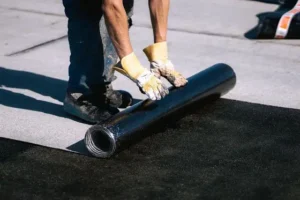Metal roof waterproofing requires the appropriate waterproofing methods and materials, which are crucial for ensuring the stability of the building structure and extending its service life. Metal roof waterproofing methods are as follows:
1. Preliminary Preparation
Before beginning metal roof waterproofing work, workers must thoroughly clean the work surface to ensure the base surface has no loose fasteners, rust, oil, dust, or visible water. Workers should promptly replace or reinforce loose fasteners to prevent leaks caused by them. Additionally, they can manually polish rusted base surfaces to restore the natural metal color. Then, they can apply a coat of rust- and corrosion-resistant paint to enhance corrosion resistance.
2. Construction Materials and Tools
Common materials for metal roof waterproofing include membranes and film-coated membranes. Membrane waterproofing materials, such as asphalt membranes, polymer-modified asphalt membranes, and synthetic polymer membranes, are capable of adapting to structural vibration and expansion and contraction. The coating waterproofing material is mainly waterproof coating, such as metal roof waterproof coating, which has excellent toughness, wear resistance and corrosion resistance, and is suitable for metal roofs exposed to outdoor environments for a long time.
In terms of construction tools, brushes, rollers, scrapers, cutting tools, measuring tools, etc. need to be prepared to ensure the smooth progress of the construction process.
3. Specific construction steps
(1)Roll waterproofing construction
- Leveling layer treatment: First, use cement mortar leveling layer with a thickness of 20mm and a cement grade of not less than 42.5. There should be partition joints on the surface layer and fill with sealing materials to prevent cracks caused by structural deformation or temperature difference deformation.
- Roll material laying: When laying the roll material, pay attention to the direction and ensure that the knots at the interface are firm. When laying roofs with multiple spans or high and low spans, it should be done in the order of high first and low, far first and near first. After laying the membrane, in order to protect it from damage by the external environment, an insulation layer is generally added, such as laying 300mm×300mm expanded perlite insulation blocks, and then adding a 3cm thick cement mortar protective layer on top of it, with a wire mesh inside to increase safety.
(2)Film waterproofing construction
- Check the quality of the leveling layer: Before applying the waterproof coating, ensure the leveling layer meets regulations and design requirements. Clean and sweep it, then repair defects such as unevenness, sanding, peeling, and cracks.
- Prepare the leveling layer treatment agent: For solvent-based waterproof coatings, dilute them with the corresponding solvent to improve penetration. For example, use gasoline as a diluent for solvent-based SBS modified asphalt waterproof coatings, with a dilution ratio of coating to gasoline = 1:0.5.
- Apply the leveling layer: First, coat the roof nodes, perimeters, corners, and other critical areas. Then, apply it to larger surfaces. Ensure even application, consistent thickness, and full coverage to strengthen adhesion between the coating and the leveling layer.
- Apply the waterproof coating: Once the leveling layer coating cures and dries, apply the waterproof coating in strips or reverse order. Layer the coating in perpendicular passes to prevent bubbles, wrinkles, pits, scratches, or other defects. Can you use liquid membranes for roof waterproofing? This step covers the roof application.
- Lay carcass reinforcement material: While applying the second or third coat, embed reinforcement materials like woven polyester cloth. Use a roller brush to press evenly, ensuring tight bonding with the coating.
- Coat the protective layer: Immediately after finishing the waterproof coating, apply the protective layer. Spread fine sand or other granular materials evenly over the wet coating, or use light-colored paint to enhance durability.
Metal roof waterproofing is a complex and meticulous task, requiring specialized knowledge and skills, strict adherence to construction specifications, and ensuring quality at every stage. Metal roof waterproofing methods, through the selection of appropriate waterproofing materials, scientific construction methods, and meticulous construction procedures, can effectively improve the waterproof performance of metal roofs and extend the life of the building.
Contact Us
For more information or to inquire about our waterproof floor paint solutions, feel free to get in touch with us. We’re here to help!
- Phone: +86 138 6365 6701
- Email: Huafengwaterproof@gmail.com
- WhatsApp: +86 138 6365 6701
We look forward to assisting you with all your waterproofing needs!






